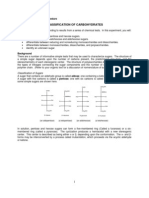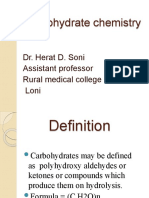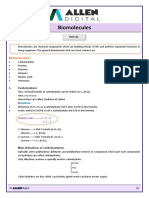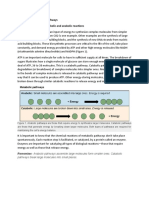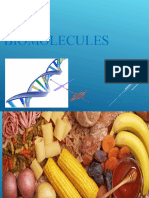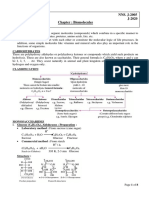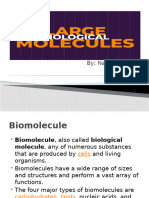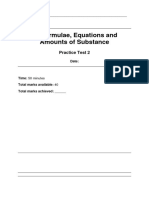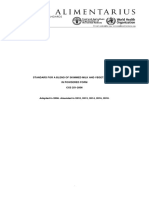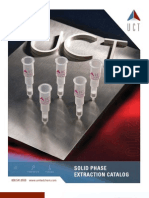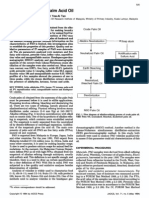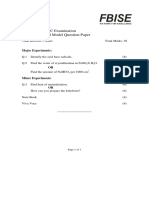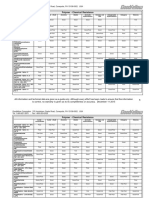Test For Sugars PDF
Test For Sugars PDF
Uploaded by
Rut ChristineCopyright:
Available Formats
Test For Sugars PDF
Test For Sugars PDF
Uploaded by
Rut ChristineOriginal Title
Copyright
Available Formats
Share this document
Did you find this document useful?
Is this content inappropriate?
Copyright:
Available Formats
Test For Sugars PDF
Test For Sugars PDF
Uploaded by
Rut ChristineCopyright:
Available Formats
R E A C
446
m o d u l a r
l a b o r a t o r y
p r o g r a m
i n
c h e m i s t r y
program editor: H. A. Neidig
Qualitative Testing for Carbohydrates
prepared by James O. Schreck, University of Northern Colorado,
and William M. Loffredo, East Stroudsburg University
Purpose of the Experiment
Study the reactions of various carbohydrates with reagents used to classify
and identify these compounds.
Background Information
The body gets its energy from three main classes of
food: carbohydrates, proteins, and fats. Of these
classes, carbohydrates are the most important
source of energy. When digesting food, the body begins to digest carbohydrates first. This process is relatively efficient, producing waste products that are innocuous (water) or readily removed (carbon dioxide).
Carbohydrates are widely distributed in plant tissues and are even found in certain animal tissues, such
as liver and muscle. Water-soluble carbohydrates often
have a sweet taste and therefore are called sugars.
Another term for carbohydrate is saccharide.
Carbohydrates are actually polyhydroxyaldehydes and polyhydroxyketones, often but not always
with the general formula (CH2O)n, where n equals 3 or
more. We refer to polyhydroxyaldehydes as aldoses
and polyhydroxyketones as ketoses.
Carbohydrates are divided into three general
classes, depending on the number of carbohydrate
molecules they contain. Individual carbohydrate molecules are classified as monosaccharides. Monosaccharides are further classified by the number of
carbon atoms they contain. For example, we call
monosaccharides containing 5 carbons, pentoses,
and those containing 6 carbon atoms, hexoses. Common examples of monosaccharides include ribose, a
five-carbon aldose known as aldopentose; glucose
and galactose, six-carbon aldoses known as aldohexoses; and fructose, a ketohexose.
Carbohydrates containing a few monosaccharide
units are classified as oligosaccharides. Oligosaccharides can be further subdivided into disaccharides
(two-monosaccharide units), trisaccharides (threemonosaccharide units), and so forth. Common examples of disaccharides are sucrose (glucosefructose),
table sugar; maltose (glucoseglucose), corn syrup;
and lactose (galactoseglucose), milk sugar.
Carbohydrates containing a large number of
monosaccharide units are classified as polysaccharides. Of the many known polysaccharides, starch,
cellulose, and glycogen are the most important. All
three are made up of hundreds of thousands of glucose units connected in various patterns. One common characteristic of all oligo- and polysaccharides is
that they can be hydrolyzed to their monosaccharide
units by heating in slightly acidic solution.
Copyright 1994 by Chemical Education Resources, Inc., P.O. Box 357, 220 S. Railroad, Palmyra, Pennsylvania 17078
No part of this laboratory program may be reproduced or transmitted in any form or by any means, electronic or mechanical, including photocopying, recording, or any information storage and retrieval system, without permission in writing from the publisher. Printed in the United
States of America
98 97 96 95 94 12 11 10 9 8 7 6 5 4 3 2 1
REAC 446/Qualitative Testing for Carbohydrates
CHO
H
C OH
C OH
acidic
dehydrating
medium
C OH
-3 H2O
H
OHC
H
C
O
furfural
CH2OH
(Eq. 1)
ribose (a pentose)
CHO
H
HO
H
H
C OH
C
C OH
C OH
acidic
dehydrating
medium
-3 H2O
H
HOCH2
H
C
CH
O
5-hydroxymethylfurfural
CH2OH
glucose (a hexose)
Figure 1 Hemiacetal formation, showing the
hemiacetal structure in the dotted box and the two
anomers
Aldoses undergo an intramolecular reaction between a hydroxyl group and the carbonyl group. The
result is a cyclic hemiacetal, shown in Figure 1. We refer to the carbonyl carbon involved in the reaction as
the anomeric carbon (C* in Figure 1). At this carbon
atom there are two stereochemical configurations possible, alpha () and beta (). The two molecules containing these configurations are called anomers.
Cyclic hemiacetal anomers are more stable than
the open-chain. Therefore, solutions of aldoses always have a higher concentration of anomers than of
open-chain aldoses. A similar intramolecular reaction
occurs between a hydroxyl group and the carbonyl
group of a ketose to form a hemiketal.
Carbohydrate test reagents can be divided into
three general classes based on the type of reaction involved. One class, dehydrating acids, causes carbohydrates to undergo dehydration, and form either
furfural (from a pentose) as shown in Equation 1 or
5-hydroxymethylfurfural (from a hexose) as shown in
Equation 2.
The presence of furfural or 5-hydroxymethylfurfural can be detected by the addition of one of the
second class of test reagents, called condensation
reagents. These are phenolic compounds that react
(Eq. 2)
with furfural or 5-hydroxymethylfurfural to yield highly
colored products. Reagents included in this class are
Molisch reagent, Bials reagent, and Seliwanoffs reagent. These two classes of reagents are frequently
used together as part of a two-step analysis.
The third class of test reagents consists of solutions containing copper(II) ions. These reagents oxidize certain carbohydrates. Two common reagents in
this class are Benedicts and Barfoeds reagents. We
refer to the carbohydrates that reduce the copper(II)
ions in these solutions to copper(I) oxide as reducing
sugars. Reducing sugars are all aldoses containing
either a free aldehyde group or a cyclic hemiacetal.
Note that under the reaction conditions used in tests
with Benedicts and Barfoeds reagents, -hydroxyketoses will also reduce copper(II) ions, giving a positive
(but incorrect) test result. This is due to the slow conversion of the -hydroxyketone group to an -hydroxyaldehyde group, as shown in Figure 2. The R attached to
the groups in Figure 2 represents the part of the molecule not involved in the reaction.
Disaccharides are oligosaccharides containing
two monosaccharide units joined by an acetal or ketal
linkage. The linkage results from the reaction of the
hemiacetal or hemiketal form of one monosaccharide
O OH
H+ or OHR C C H
H
-hydroxyketone
HO O
R C C H
H
-hydroxyaldehyde
Figure 2 Conversion of an -hydroxyketone to
an -hydroxyaldehyde
REAC 446/Qualitative Testing for Carbohydrates
CH2OH
C
OH H
OH
OH
HO
OH H
OH
OH
HO
-glucose
OH H
OH
OH
-glucose
Figure 3
-H2O
+H2O
-glucose
CH2OH
HO
CH2OH
CH2OH
CH2OH
+
CH2OH
OH H
OH H
OH
OH
HO
OH
(a)
maltose
CH2OH
H
OH C
HO
OH
-H2O
+H2O
CH2OH
-fructose
OH H
HO
OH
CH2OH
C
O
OH C
OH
CH2OH
sucrose
(b)
(a) Formation of a reducing disaccharide; (b) formation of a nonreducing disaccharide
with one of the hydroxyl groups on another monosaccharide. Disaccharides containing a free hemiacetal or
hemiketal, such as maltose in Figure 3(a), are reducing
sugars. Disaccharides containing no free hemiacetals
or hemiketals, such as sucrose in Figure 3(b), are nonreducing sugars. As shown in Figure 3, disaccharide
linkages can be broken by the addition of water. This reaction occurs slowly, but it can be catalyzed by acidic
media.
Identifying Products of Carbohydrate
Condensation Reactions
Many carbohydrates can be identified using condensation reagents, which react with the carbohydrates to
produce highly colored products. The precise nature of
the condensation reaction varies with the carbohydrate under investigation. Often the carbohydrate is
initially dehydrated into smaller saccharide units, using
a dehydrating acid. The smaller units, or molecules,
formed will produce a more highly colored complex
with the condensation reagent, as in Molischs, Bials,
and Seliwanoffs tests. In other cases the carbohydrate must possess certain structural features that allow it to form a condensation product, such as in the iodine and potassium iodide test (I2/KI). The following
section describes two types of condensation reactions: those used to generally classify carbohydrates,
and those used to identify specific carbohydrates.
Molisch test
The Molisch test uses concentrated sulfuric acid
as the dehydrating acid. This acid dehydrates all
carbohydrates, so the test is used to distinguish between carbohydrates and non-carbohydrates. The
dehydration products of carbohydrates, furfural or
5-hydroxymethylfurfural, result from the reaction of
the sulfuric acid with pentoses and/or hexoses (Eq.
1 and 2). These products condense with -naphthol
to yield a purple condensation product. The two-step
process is represented by Equation 3.
carbohydrate dehydration product
purple product
(Eq. 3)
Iodine and Potassium Iodide Test
Starches form deeply colored blue-black complexes with iodine. Starches contain -amylose, a helical saccharide polymer, and amylopectin. Iodine forms
a large complex polysaccharide with the -amylose
helix, producing the blue-black color. Simpler oligosaccharides and monosaccharides do not form this
complex with iodine. Thus, the I2/KI test can be used to
distinguish starches from other carbohydrates.
Bials Test
Bials test uses concentrated hydrochloric acid as
the dehydrating acid and orcinol with a trace of iron(III)
chloride as the condensation reagent. Bials test is
used to distinguish between pentoses and hexoses.
Pentoses subjected to the test yield a blue or green
condensation product, while hexoses yield a muddy
brown-to-gray condensation product, as shown in
Equations 4 and 5.
pentose dehydration product:
furfural
blue or green condensation product
(Eq. 4)
REAC 446/Qualitative Testing for Carbohydrates
hexose dehydration product:
5-hydroxymethylfurfural
muddy brown-gray condensation product
(Eq. 5)
R CHO
reducing + 2 Cu 2 + + 2 H2 O
saccharide
R COOH
carboxylic + Cu 2 O (s, red) + 4 H+
acid
(Eq. 8)
Seliwanoffs Test
Seliwanoffs test uses 6M hydrochloric acid as the
dehydrating acid and resorcinol as the condensation
reagent. Seliwanoffs test is used to distinguish between aldoses and ketoses. When mixed with Seliwanoffs reagent, ketopentoses and ketohexoses react within
2 minutes to form a cherry-red condensation product,
as shown in Equation 6.
ketose dehydration product
cherry-red product
(Eq. 6)
(within 2 min)
Aldopentoses react after 2 minutes to form a blue-green
condensation product, which may further change to a
peach color.
Identifying Reducing Sugars
In this experiment, you will use the various
reagents to test and classify several carbohydrate solutions. You will classify the carbohydrates according
to the number of molecules contained in the structure
and the number of carbon atoms in the carbohydrate
unit. You will also determine whether the carbohydrate
is an aldose or ketose, and whether it is reducing or
nonreducing. A classification flow chart used for carbohydrate identification in this experiment is shown in
Figure 4 on the next page. You must make careful observations of both positive and negative results for
each classification test. Using these observations, you
will qualitatively identify an unknown carbohydrate
solution.
Reducing sugars are oxidized by copper(II) ions in two
other saccharide test solutions: Benedicts reagent, a
mildly basic solution, and Barfoeds reagent, a mildly
acidic solution. The presence of red copper(I) oxide
precipitate indicates that the saccharide has reduced
the copper(II) ions.
Procedure
Chemical Alert
Molisch reagenttoxic and corrosive
iodinepotassium iodide reagenthighly toxic,
corrosive, and irritant
Barfoeds reagentcorrosive and irritant
Bials reagenttoxic and corrosive
Benedicts reagenttoxic and irritant
Seliwanoffs reagenttoxic and corrosive
concentrated sulfuric acidtoxic and corrosive
Benedicts Test
Benedicts test uses a mixture of copper(II) sulfate, sodium citrate, and sodium carbonate in a mildly
basic solution. This reagent is used as a general test
for detecting reducing sugars. If the saccharide is a reducing sugar, it will reduce the copper(II) ions to copper(I) oxide, a red precipitate, as shown in Equation 7.
R CHO
reducing
+ 2 Cu 2+ + 5 OH
carbohydrates
R CO 2
carbohydrate + Cu 2 O (s, red) + 3 H2 O
ion
(Eq. 7)
Barfoeds Test
Barfoeds test uses copper(II) ions in a slightly
acidic medium. If the reaction time is carefully monitored, this test can be used to distinguish reducing
monosaccharides from reducing disaccharides. Reducing monosaccharides cause the formation of copper(I) oxide within 23 minutes. Reducing disaccharides cause the formation of copper(I) oxide after
approximately 10 minutes.
Caution: Wear departmentally approved eye
protection while doing this experiment.
I.
Reacting Known Carbohydrate Solutions
Note: Because test tubes are placed in a boiling-water bath, you will need to label them by
marking the etched glass portion on the tube using either a pencil or marking pen. Do not use paper labels, which can become loose in the hot
water.
1. Label three sets of 7 clean, dry 18 150-mm test
tubes with the names of each of the seven carbohydrate solutions you are testing.
REAC 446/Qualitative Testing for Carbohydrates
Figure 4
Flow chart for classifying an unknown carbohydrate
2. Obtain from your laboratory instructor, and transfer into one set of seven labeled test tubes, 10 mL of
each of the following 1% carbohydrate solutions:
xylose, fructose, glucose, lactose, sucrose, maltose,
and starch.
Molisch Test
Caution: Molisch reagent contains concentrated sulfuric acid, which is toxic and corrosive.
It can cause severe burns. Prevent eye, skin,
clothing, and combustible material contact. Avoid
ingesting the substance. If you spill any reagent
or acid, immediately notify your laboratory
instructor.
Note: Do not place your thumb over the open
end of a test tube when mixing its contents. Your
laboratory instructor will suggest ways in which
you can safely and thoroughly mix the contents of
a test tube.
3. Transfer 2 mL of each of the carbohydrate solutions from the first set of labeled test tubes into the
REAC 446/Qualitative Testing for Carbohydrates
second set. Add 2 drops of Molisch reagent to each
tube in the second set, and mix well with a clean glass
stirring rod.
Add 2 mL of concentrated sulfuric acid to each of
the test tubes in the third set.
Caution: In the next step, you will be adding
aqueous solutions to concentrated sulfuric acid.
You must be extremely careful while performing
this step.
4. One at a time, hold the test tubes containing the
concentrated sulfuric acid at an angle of about 30
from the vertical and slowly pour the carbohydrateMolisch reagent solutions from the second set
of test tubes into them. Do not shake or mix the resulting solutions. Two separate layers will form.
Note: When testing your unknown in Step 5, if
there is no color change at the interface between
the two layers, the test result is negative. Do not
continue the tests for the samples that test negative for the Molisch test.
5. Record your results on Data Sheet 1.
6. Discard the test solutions containing Molisch reagent into the container provided by your laboratory
instructor and labeled Discarded Molisch Reagent
Solutions.
7. Wash the second and third sets of test tubes with
soap or detergent solution. Rinse three times with tap
water and once with distilled or deionized water. Allow
the test tubes to drain in order to remove as much of
the water as possible.
Iodine and Potassium Iodide Test
9. Record on Data Sheet 1 the positive or negative
results that you observe after you mix the solutions
with the I2/KI reagent.
10. Discard the test solutions containing the I2/KI solution into the container provided by your laboratory instructor and labeled Discarded I2/KI Solutions.
11. Wash the test tubes with soap or detergent solution. Rinse three times with tap water and once with
distilled water. Allow the test tubes to drain.
Caution: In the next four tests you will place
the test tubes containing the reaction solutions in
a boiling-water bath. Be careful that you do not
come in contact with the steam or the hot apparatus, and that you do not knock over the bath.
Note: Before using the boiling-water bath, be
sure to add two boiling chips to the beaker of water, in order to prevent the test tubes from bumping as the water boils.
12. To set up a boiling-water bath, place an 800-mL
beaker through an iron support ring small enough that
the lip of the beaker will not pass through it. Clamp the
ring and beaker to a support stand. Place a ceramic-centered wire gauze on a tripod or another iron
ring support under the beaker. If you use a ring, clamp
it to the support stand. Add 350 mL of water to the
beaker, along with two boiling chips. Heat the water to
boiling, using a Bunsen burner flame placed under the
beaker.
Barfoeds Test
Caution: Barfoeds reagent is corrosive and an
irritant. If you spill any of the solution on yourself
or on the bench, immediately notify your laboratory instructor.
Caution: The I2/KI solution is toxic, corrosive,
and an irritant. If you spill any of the solution on
yourself or on the bench, immediately notify your
laboratory instructor.
Note: A red precipitate before 5 min have
elapsed indicates a positive result for a reducing monosaccharide. If a red precipitate appears at about 10 min, the sample is a reducing
disaccharide.
8. Transfer 2 mL of each of your carbohydrate solutions into one set of the washed, drained, labeled test
tubes. Add 2 drops of the I2/KI solution to each test
tube.
13. Transfer 1 mL of each of your carbohydrate solutions into one set of the washed, drained test tubes.
Add 3 mL of Barfoeds reagent to each test tube. Using
a test tube clamp, place the test tubes containing the
REAC 446/Qualitative Testing for Carbohydrates
reaction mixtures in your boiling-water bath. Note the
time on Data Sheet 1. Allow the test tubes to stand in
the boiling-water bath for 5 min. After 5 min, use the
test tube clamp to cautiously remove the hot test tubes
and observe the contents. Replace in the boiling-water
bath for 5 additional minutes any test tubes that have
no red precipitate. Cool under running water any test
tubes that contain a red precipitate. Place the cool test
tubes from the bath in a test tube rack.
21. Add 3 mL of Benedicts reagent to each of the test
tubes in one set. Then transfer 10 drops of each of
your carbohydrate solutions to the appropriately labeled tubes. Using a test tube clamp, place the test
tubes containing the reaction mixtures in the boiling-water bath. After exactly 2 min, use the test tube
clamp to remove the test tubes, and place them in a
test tube rack.
14. Record the time for Barfoeds test on Data Sheet 1.
22. Record all observations and the color of any precipitate on Data Sheet 1.
15. Discard the test solutions containing Barfoeds reagent into the container provided by your laboratory instructor and labeled Discarded Barfoeds Reagent
Solutions.
23. Discard the test solutions containing Benedicts
reagent into the container provided by your laboratory
instructor and labeled Discarded Benedicts Reagent
Solutions.
16. Wash the test tubes with soap or detergent solution. Rinse three times with tap water and once with
distilled water. Allow the test tubes to drain.
24. Wash, rinse, and drain the test tubes as before.
Seliwanoffs Test
Caution: Seliwanoffs reagent is toxic and corrosive. If you spill any of the solution on yourself
or on the bench, immediately notify your laboratory instructor.
17. Transfer 10 drops of each of your carbohydrate
solutions to one set of drained test tubes. Then add 15
drops of distilled water and 9 mL of Seliwanoffs reagent to each test tube. Using a test tube clamp, carefully place the test tubes containing the reaction mixtures in the boiling-water bath. Do not allow the test
tubes to stand in the bath for more than 2.5 min. Use
the test tube clamp to carefully remove the test tubes
from the bath, place them in a test tube rack, and observe the solution color in each one.
18. Record your observations for Seliwanoffs test on
Data Sheet 1.
19. Discard the test solutions containing Seliwanoffs
reagent into the container provided by your laboratory
instructor and labeled Discarded Seliwanoffs Reagent Solutions.
20. Wash, rinse, and drain the test tubes as before.
Benedicts Test
Caution: Benedicts reagent is toxic. If you spill
any of the solution on yourself or on the bench,
immediately notify your laboratory instructor.
Bials Test
Caution: Bials reagent is toxic and corrosive.
Use a fume hood when working with Bials reagent. If you spill any of the solution on yourself
or on the bench, immediately notify your laboratory instructor.
25. Add 3 mL of Bials reagent to each of the test
tubes in one set. Then transfer 2 drops of each of your
carbohydrate solutions to the appropriately labeled
test tubes. Using a test tube clamp, place the test
tubes containing the reaction mixtures in the boiling-water bath. Record the time on Data Sheet 1. Use
the clamp to remove each test tube from the bath as
soon as you see a color change. Place the tube in a
test tube rack and record the time on Data Sheet 1. Do
not allow the test tubes to stand in the bath for more
than 5 min, even if no color change occurs.
26. Record the color change on Data Sheet 1, and
calculate the time it took for the color to change.
27. Discard the test solutions containing Bials reagent
into the container provided by your laboratory instructor
and labeled Discarded Bials Reagent Solutions.
28. Discard your carbohydrate test solutions into the
drain, diluting with a large amount of running water.
Wash, rinse, and drain all of the glassware as before.
Note: Leave the boiling-water bath set up, so
you can use it for the unknown carbohydrate solution in Part II.
REAC 446/Qualitative Testing for Carbohydrates
Identifying an Unknown Carbohydrate
Solution
stop as soon as you have identified your unknown solution. Record all observations on Data Sheet 2.
Note: Each of the tests in Part I distinguishes
between two classes of carbohydrates. It may
not be necessary to perform all of the tests in order to identify your unknown sample in Part II.
Note: If your laboratory instructor asks you to
identify additional unknown carbohydrate solutions, prepare additional copies of Data Sheet 2.
29. Obtain 10 mL of a 1% unknown carbohydrate solution from your laboratory instructor in a washed and
drained, 18 150-mm test tube. The unknown carbohydrate solution will be one of the solutions you tested
in Part I. Label the test tube with the identification code
for the unknown, and record the code on Data Sheet 2.
31. Dispose of your solutions in the appropriate containers. Wash, rinse, and drain any glassware you
have used.
II.
Caution: Wash your hands thoroughly with
soap or detergent before leaving the laboratory.
30. Repeat the tests outlined in Part I, Steps 328,
using your unknown carbohydrate solution. You may
Post-Laboratory Questions
(Use the spaces provided for the answers and additional paper if necessary.)
1. When an aldose reacts with Barfoeds reagent,
what type of organic compound forms? What type of
chemical reaction is this?
2. Explain why fructose, an -hydroxyketose, reacts
with Benedicts reagent. What structural rearrangement is necessary for this reaction to occur?
4. An unknown carbohydrate solution tested positive
with Molisch reagent, formed a red precipitate with
Barfoeds reagent within 3 minutes, and turned
blue-green when mixed with Bials reagent. What carbohydrate is this?
5. Erythrose is a four-carbon aldose. Describe the
results of testing it with the following reagents.
(1) Molisch
(2) Barfoeds
3. Explain what happened when you mixed sucrose
with Seliwanoffs reagent. Was this the result you expected? Briefly comment.
(3) Benedicts
(4) Seliwanoffs
name
section
date
name
section
date
Data Sheet 1
I.
Reacting Known Carbohydrate Solutions
test
reagent
saccharide solution
xylose
fructose
glucose
lactose
sucrose
maltose
starch
Molisch
________
________
________
________
________
________
________
I2/KI
________
________
________
________
________
________
________
Barfoeds
time:
final
________
________
________
________
________
________
________
________
________
________
________
________
________
________
initial
________
________
________
________
________
________
________
elapsed
________
________
________
________
________
________
________
Seliwanoffs
time:
final
________
________
________
________
________
________
________
________
________
________
________
________
________
________
initial
________
________
________
________
________
________
________
elapsed
________
________
________
________
________
________
________
Benedicts
time:
final
________
________
________
________
________
________
________
________
________
________
________
________
________
________
initial
________
________
________
________
________
________
________
elapsed
________
________
________
________
________
________
________
________
________
________
________
________
________
________
________
________
________
________
________
________
________
initial
________
________
________
________
________
________
________
elapsed
________
________
________
________
________
________
________
Bials
time:
final
REAC 446/Qualitative Testing for Carbohydrates
10
REAC 446/Qualitative Testing for Carbohydrates
Data Sheet 2
II.
Identifying an Unknown Carbohydrate Solution
unknown identification code ________________
test reagent
observation
conclusion
Molisch
________________________________
________________________________
I2/KI
________________________________
________________________________
Barfoeds
time:
final
________________________________
________________________________
initial
________________________________
elapsed
________________________________
Seliwanoffs
time:
final
________________________________
________________________________
________________________________
initial
________________________________
elapsed
________________________________
Benedicts
time:
final
________________________________
initial
________________________________
elapsed
________________________________
Bials
time:
final
________________________________
________________________________
________________________________
________________________________
________________________________
initial
________________________________
elapsed
________________________________
________________________________
name
section
date
Pre-Laboratory Assignment
1. Describe the hazards associated with the following test reagents.
(1) Molisch
3. Classify the following saccharides as either reducing or nonreducing sugars.
(1) ribose
(2) Bials
(2) sucrose
(3) Seliwanoffs
(3) hydrolyzed starch
2. Briefly explain the meanings of the following terms
as they relate to this experiment. Include structural formulas if appropriate.
(1) aldohexose
4. For each of the following test reagents, describe
the appearance of the reaction mixture that indicates a
positive result.
(1) iodine/potassium iodide solution
(2) reducing sugar
(2) Benedicts
(3) hemiacetal
(3) Seliwanoffs
REAC 446/Qualitative Testing for Carbohydrates
11
12
REAC 446/Qualitative Testing for Carbohydrates
5. For each of the following test reagents, describe
the class and give a specific example of a carbohydrate that would yield a positive result.
(1) iodine/potassium iodide solution
6. Which test could you use to distinguish between
the following pairs of carbohydrates?
(1) fructose and galactose
(2) ribose and glucose
(2) Benedicts reagent
(3) glucose and maltose
(3) Seliwanoffs reagent
ISBN 0-87540-446-4
You might also like
- Method Statement For In-Situ Metallography Test: DCSM Project 2019Document5 pagesMethod Statement For In-Situ Metallography Test: DCSM Project 2019Thinh NguyenNo ratings yet
- Lecture 3 Carbohydrates 1-1Document67 pagesLecture 3 Carbohydrates 1-1Nuhu SibaNo ratings yet
- Carbohydrates LabDocument15 pagesCarbohydrates LabFrancis Ryannel S. De CastroNo ratings yet
- Biomolecules notesDocument21 pagesBiomolecules notesjapjeesharmaNo ratings yet
- BiomoleculesDocument32 pagesBiomoleculesspandhan reddyNo ratings yet
- Unit-14 BiomoleculesDocument25 pagesUnit-14 BiomoleculesjagannathanNo ratings yet
- BiomoleculesDocument8 pagesBiomoleculesselvaufoNo ratings yet
- Chapter-Iii:Biomolecules: CarbohydratesDocument12 pagesChapter-Iii:Biomolecules: Carbohydratesbereket gashuNo ratings yet
- Qualitative Analysis of Carbohydrates ExperimentDocument12 pagesQualitative Analysis of Carbohydrates Experimentasdf65365254750% (2)
- DETECTION_OF_CARBOHYDRATESDocument10 pagesDETECTION_OF_CARBOHYDRATESReman A. AlingasaNo ratings yet
- Carbohydrates and Alterations in Glucose Metabolisme Kimia KlinikDocument7 pagesCarbohydrates and Alterations in Glucose Metabolisme Kimia Klinikfhera TJNo ratings yet
- UNIT4 Expt1Document6 pagesUNIT4 Expt1Christian Franco RuizNo ratings yet
- Chapter 14 XII ChemDocument20 pagesChapter 14 XII Chemfrstargirl1No ratings yet
- FST613 5 CarbohydratesDocument113 pagesFST613 5 CarbohydratesmohamadbarsyikNo ratings yet
- Industrial Applications of Enzymes: CarbohydratesDocument22 pagesIndustrial Applications of Enzymes: CarbohydratesH.J.PrabhuNo ratings yet
- Extraction and Hydrolysis of Glycogen and Characterization Tests For CarbohydratesDocument7 pagesExtraction and Hydrolysis of Glycogen and Characterization Tests For CarbohydratesangelsiopaoNo ratings yet
- CarbohydratesDocument22 pagesCarbohydratesMaris JoyceNo ratings yet
- 2 CarbohydrateDocument37 pages2 Carbohydratesima mhammedNo ratings yet
- Revision Notes On CBSE Class 12 Chemistry Chapter 14 - Biomolecules Free PDFDocument37 pagesRevision Notes On CBSE Class 12 Chemistry Chapter 14 - Biomolecules Free PDFBiswa JitNo ratings yet
- Organicchemistry 1Document33 pagesOrganicchemistry 1johnpaulinusogyeNo ratings yet
- BiomoleculesDocument23 pagesBiomoleculesSaraswati maharanaNo ratings yet
- HSSRPTR - Biomolecules HSS+2Document11 pagesHSSRPTR - Biomolecules HSS+2avallenjosephviiiaNo ratings yet
- II PUC Chemistry Unit 14Document5 pagesII PUC Chemistry Unit 14smitakamath6686No ratings yet
- Biomolecules 0Document6 pagesBiomolecules 0HYBROS GAMINGNo ratings yet
- 07 Carbohydrate LabDocument9 pages07 Carbohydrate LabCrizielle GarciaNo ratings yet
- Biomolecules RevisedDocument12 pagesBiomolecules Revisednu7451667No ratings yet
- Carbohydrate Chemistry: Dr. Herat D. Soni Assistant Professor Rural Medical College LoniDocument117 pagesCarbohydrate Chemistry: Dr. Herat D. Soni Assistant Professor Rural Medical College LoniWwwanand111No ratings yet
- Biomolecules NOTES (A)Document13 pagesBiomolecules NOTES (A)ABHAYNo ratings yet
- Carbohydrate Chemistry: Dr. Herat D. Soni Assistant Professor Rural Medical College LoniDocument117 pagesCarbohydrate Chemistry: Dr. Herat D. Soni Assistant Professor Rural Medical College LoniMahmudur RahmanNo ratings yet
- 5 6100500212126580750 PDFDocument94 pages5 6100500212126580750 PDFRizziel NemesNo ratings yet
- BiomoleculesDocument22 pagesBiomoleculesanushka mohantyNo ratings yet
- Carbohydrates TestsDocument4 pagesCarbohydrates TestsTk MakotoseNo ratings yet
- Biomolecules SheetDocument21 pagesBiomolecules SheetMahendra Shah100% (1)
- DOC-20241112-WA0001.Document19 pagesDOC-20241112-WA0001.varunmisriNo ratings yet
- Exercise 8 (Carbonyl Compounds and Carbohydrates)Document9 pagesExercise 8 (Carbonyl Compounds and Carbohydrates)Wendell Kim Llaneta0% (1)
- 1-Carbohydrates 1Document20 pages1-Carbohydrates 1oxfordybfvNo ratings yet
- Hsslive Xii CH 10 Biomolecules AnilDocument8 pagesHsslive Xii CH 10 Biomolecules AnilFathima NithinshaNo ratings yet
- Introduction To CarbohydratesDocument6 pagesIntroduction To CarbohydratesKhazel CasimiroNo ratings yet
- 4 Biochemical Engineering CH 4Document44 pages4 Biochemical Engineering CH 4Barnabas YohannesNo ratings yet
- BIOMOLECULESDocument26 pagesBIOMOLECULESVicky VigneshNo ratings yet
- CarbohydratesDocument38 pagesCarbohydratesSandeep MitraNo ratings yet
- Biomolecules chapterDocument44 pagesBiomolecules chapterarman210107No ratings yet
- Carbohydrate ExperimentDocument42 pagesCarbohydrate ExperimentYulinar Fawanys100% (1)
- Bio MoleculesDocument12 pagesBio MoleculesMohammed IliasNo ratings yet
- Class Xii Bio MoleculesDocument22 pagesClass Xii Bio MoleculesSiddharth GuptaNo ratings yet
- Biochemistry of Enzymes, Carbohydrates & LipidsDocument71 pagesBiochemistry of Enzymes, Carbohydrates & LipidsArdy Novrianugrah0% (1)
- Experiment 3 - CarbohydratesDocument15 pagesExperiment 3 - CarbohydratesNur Setsu100% (1)
- Carbohydrates NoteDocument11 pagesCarbohydrates Noteadebisiabdulsamad74No ratings yet
- CHO Classification, Example, Chemical Structure, FuctiDocument108 pagesCHO Classification, Example, Chemical Structure, FuctiYo'el Onaznam50% (2)
- Biomolecules Key ponits_115834Document6 pagesBiomolecules Key ponits_115834koushkrish0407No ratings yet
- MBBS Carbohydrate - ChemistryDocument66 pagesMBBS Carbohydrate - ChemistryRaj PatelNo ratings yet
- BiomoleculesDocument8 pagesBiomoleculesOM SableNo ratings yet
- 1ST SEM BIO CHEMISTRY 2020 21 Converted ProtectedDocument84 pages1ST SEM BIO CHEMISTRY 2020 21 Converted Protectedshaheenasiddiqui62No ratings yet
- Introductions and ObjectivesDocument5 pagesIntroductions and Objectivesariff sharfanNo ratings yet
- Colorimetric Determination of Carbohydrate UnknownsDocument6 pagesColorimetric Determination of Carbohydrate Unknownsmogn8586% (7)
- Bio moleculesDocument104 pagesBio moleculesnajma akhtarNo ratings yet
- BIOMOLECULES Plustwo Chemistry HssliveDocument5 pagesBIOMOLECULES Plustwo Chemistry HssliveKunal Goel100% (3)
- CarbohydratesDocument50 pagesCarbohydratesnasima.mukta1971No ratings yet
- Biochemistry Applied to Beer Brewing - General Chemistry of the Raw Materials of Malting and BrewingFrom EverandBiochemistry Applied to Beer Brewing - General Chemistry of the Raw Materials of Malting and BrewingRating: 4 out of 5 stars4/5 (1)
- Fast Facts: Long-Chain Fatty Acid Oxidation Disorders: Understand, Identify and SupportFrom EverandFast Facts: Long-Chain Fatty Acid Oxidation Disorders: Understand, Identify and SupportNo ratings yet
- Karyotype ActivityDocument4 pagesKaryotype ActivityRut ChristineNo ratings yet
- Unit 6 & 7 Cell EnergyDocument17 pagesUnit 6 & 7 Cell EnergyRut ChristineNo ratings yet
- Centennial BookDocument60 pagesCentennial BookRut ChristineNo ratings yet
- Sponges Eng 01Document8 pagesSponges Eng 01Rut ChristineNo ratings yet
- Gumti Drilling Chemicals InventoryDocument5 pagesGumti Drilling Chemicals InventoryPiplu DasNo ratings yet
- Perchlorate 3Document197 pagesPerchlorate 3HENRY RODRIGO CHUCO BAILONNo ratings yet
- Tribology - Fundamentals and Advancements (PDFDrive)Document330 pagesTribology - Fundamentals and Advancements (PDFDrive)leoyogeshNo ratings yet
- Experiment 6Document3 pagesExperiment 6Yurii NakadaiNo ratings yet
- Monosaccharides: AlpineDocument12 pagesMonosaccharides: AlpineReigner Jay B. EscartinNo ratings yet
- Report 2 GROUP 2 GENETICS LABDocument6 pagesReport 2 GROUP 2 GENETICS LABPhương ThùyNo ratings yet
- 1Document6 pages1James Rholdan PiedadNo ratings yet
- Se Cies Mama Cana Ue Acne R Ore Marne Car: R Pms Ane 1 IbleDocument830 pagesSe Cies Mama Cana Ue Acne R Ore Marne Car: R Pms Ane 1 IbleBranko NikolicNo ratings yet
- Calculations Practice Test 2 - 2021Document15 pagesCalculations Practice Test 2 - 20217644c6xg6gNo ratings yet
- S. Kiss, M. Simihăian (Auth.) - Improving Efficiency of Urea Fertilizers by Inhibition of Soil Urease Activity-Springer Netherlands (2002) PDFDocument427 pagesS. Kiss, M. Simihăian (Auth.) - Improving Efficiency of Urea Fertilizers by Inhibition of Soil Urease Activity-Springer Netherlands (2002) PDFPablo GutierrezNo ratings yet
- Car Com Beckmann RearrangementDocument9 pagesCar Com Beckmann RearrangementCBIT CIVIL A1No ratings yet
- Cxs - 251e - Blend of Skimmed Milk and Vegetable FatDocument5 pagesCxs - 251e - Blend of Skimmed Milk and Vegetable FatMuhammad Ikhsan 'icansensei'No ratings yet
- Cbse Test Paper-02 CLASS - XII CHEMISTRY (Alcohols, Phenols and Ethers)Document3 pagesCbse Test Paper-02 CLASS - XII CHEMISTRY (Alcohols, Phenols and Ethers)Shreyash KolekarNo ratings yet
- Exp7 Fischer EsterificationDocument2 pagesExp7 Fischer EsterificationgirlonfireNo ratings yet
- Crime Scene Chemistry: The Cool Blue Light of LuminaDocument7 pagesCrime Scene Chemistry: The Cool Blue Light of Lumina288 SSCN Mit Harish MaratheNo ratings yet
- Uct Spe CatalogDocument80 pagesUct Spe Catalogmarald4432No ratings yet
- Palm Acid OilDocument4 pagesPalm Acid OilWeizhan LeeNo ratings yet
- N GDY3 MK 6 PF 49 T 9 BTSGGHDocument38 pagesN GDY3 MK 6 PF 49 T 9 BTSGGHAdam Ali619No ratings yet
- Blue BC Blue CLF Red FBB S4R Brown S3R: BlusbbDocument186 pagesBlue BC Blue CLF Red FBB S4R Brown S3R: Blusbbit.amt38No ratings yet
- Coursebook Answers: Science in ContextDocument4 pagesCoursebook Answers: Science in ContextAditi100% (1)
- Chemistry Salt Analysis CheatsheetDocument5 pagesChemistry Salt Analysis CheatsheetArham KhalidNo ratings yet
- Kinetics Questions (Solutions)Document11 pagesKinetics Questions (Solutions)Lee Jun HuiNo ratings yet
- Corrosion Rate API 581Document6 pagesCorrosion Rate API 581Indra Mulyana100% (2)
- 3a 3b ANSWERS Equations (2017) Pages 61-64Document1 page3a 3b ANSWERS Equations (2017) Pages 61-64Karina LeungNo ratings yet
- Polymer - Physical PropertiesDocument31 pagesPolymer - Physical PropertiessudarshanNo ratings yet
- Aldehyde, Ketones and Carboxylic AcidDocument25 pagesAldehyde, Ketones and Carboxylic AcidBhavesh KNo ratings yet
- Formula Sheet EquilibriumDocument5 pagesFormula Sheet EquilibriumAnpaulNo ratings yet
- TOM TAILOR Group RSL Adults 12.2019Document4 pagesTOM TAILOR Group RSL Adults 12.2019Rezoanul HaqueNo ratings yet
- KCSE-FORM-2-CHEMISTRY-NOTES (1)Document143 pagesKCSE-FORM-2-CHEMISTRY-NOTES (1)Benjamin ObatNo ratings yet
























